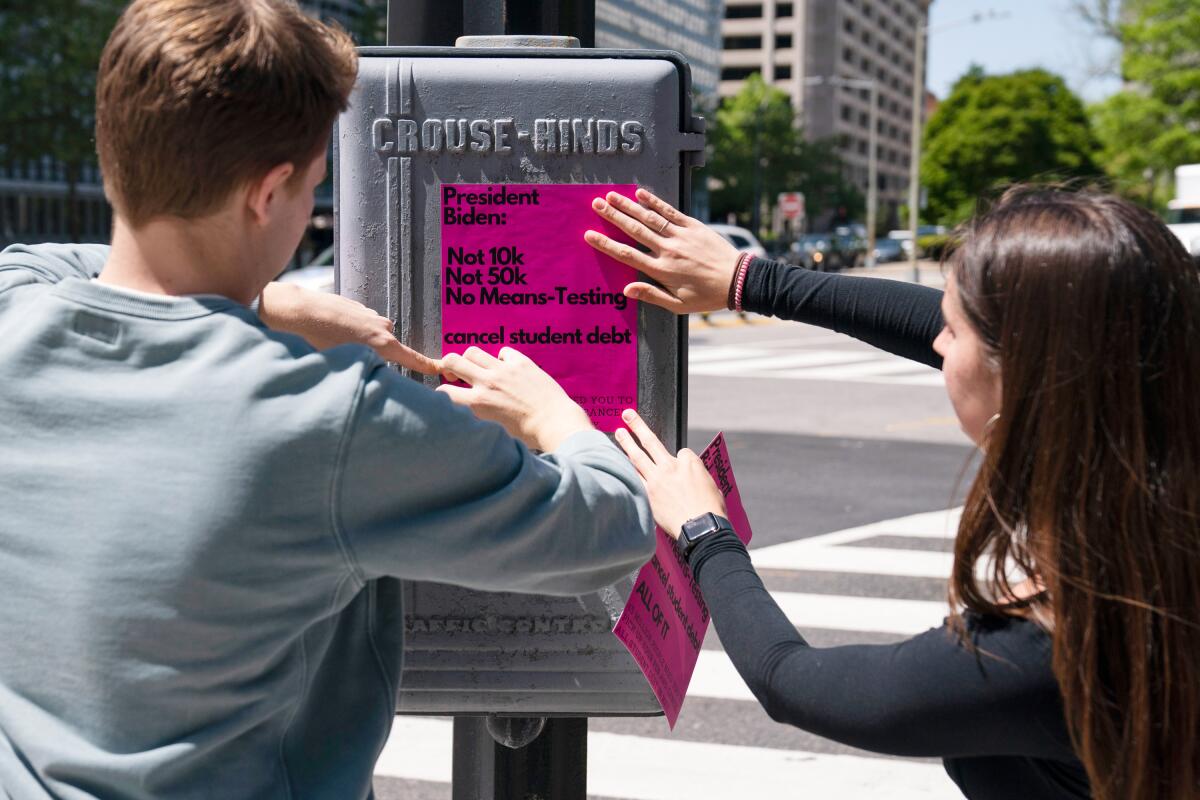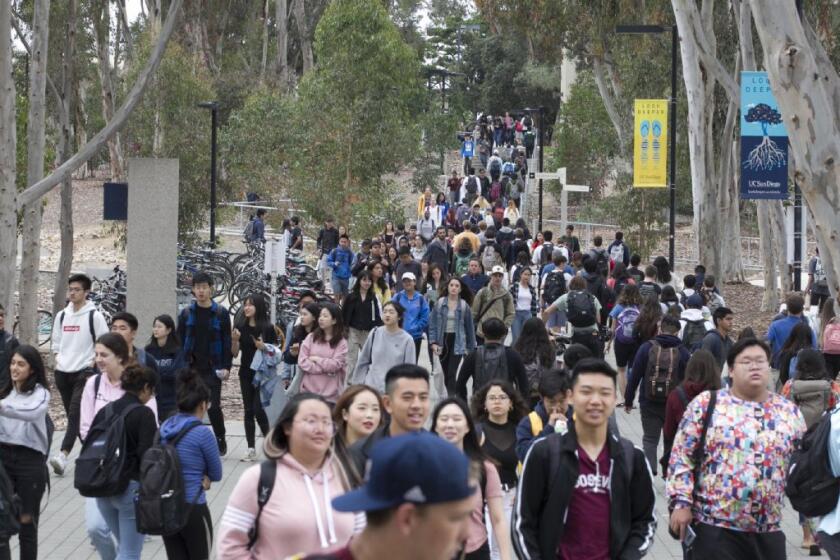Editorial: The problem with college debt is that we never fix the causes

- Share via
President Biden has wisely resisted pressure to issue blanket forgiveness for graduates’ college debt of up to $50,000 per borrower. Instead, the president has chosen more targeted — and fair — approaches.
Those have included allowing debtors to stop paying on their loans during the pandemic without owing any additional interest on the loan; canceling the debt of severely disabled grads and those who were taken in by for-profit schools that made false promises or that closed down before they could finish their education; and making fixes to the troubled program under which students were supposed to receive debt relief if they entered public service.
The public-service debt relief program was tangled in inexplicable delays and checks were withheld because of bad communication between loan servicers and lenders. Under the Biden administration, more than 110,000 graduates in that program have now received an average of $60,000 each in loan forgiveness, and potentially hundreds of thousands more will now benefit as well.
But another form of student debt relief is about to end in August — the pandemic-era moratorium on payments. As a result, Biden faces renewed pressure to make a sweeping, $1-trillion loan forgiveness of up to $50,000 per borrower that would wipe out two-thirds of the college debt in the country. He has indicated that he’s more inclined toward canceling $10,000 of debt, which would cost less than half as much and reach the largest number of students per dollar.
Students who withdrew from college during COVID are still on the hook for Pell Grant funds their schools received. Sound crazy? That’s because it is.
There’s no doubt that student debt has mired many Americans — about 43 million — in debt. Not all of those are unable to meet their obligations and not all of the debt involves federally guaranteed loans. But economists have shown that the added financial strain keeps many borrowers from buying homes and cars and starting families — a trickle-down effect on the economy and social structure of the nation. Total debt has climbed precipitously, nearly doubling in the decade from 2011 to 2021.
No matter what course Biden takes at this point, though, what’s missing is a plan to permanently reduce student debt through basic college reform. After all, today’s college graduates might get relief, but what about next year’s grads, and those in the years and decades to come?
Free college as modeled on the systems of other nations isn’t the answer. German public universities, for example, are tuition-free but bare-bones; few are admitted; students generally live at home and commute, class sizes are large, and student activities and services scant. And, like Germany, governments in other nations are willing to foot the tuition bill.
Still, the U.S. and its colleges could learn lessons from other countries about keeping costs down. Team sports, most of which are heavily subsidized at schools here, play a much smaller role in other nations. The number of administrators is much lower; bloated administrative costs are the primary driver of ballooning college prices in this country. The Department of Education should be putting colleges on notice that they must reduce these costs to continue receiving federal aid.
Not everyone wants or needs a four-year degree. Apprenticeships, part-time learning and other workforce development ideas would make the economy fairer.
Another solution is to give high school graduates the option to get skills training without having to obtain a degree. The U.S. and its employers have overemphasized four-year college degrees for earning a good living rather than the skills needed to do the job. It’s about time American high school students had access to paid apprenticeships along the lines of those offered in countries such as Switzerland to students who aren’t college-bound. That’s not just for work in the trades; students can enter professional, white-collar careers in management, banking, programming, customer service and many more fields through these apprenticeships.
The federal government also should provide incentives for thrifty behavior by college students who attend public rather than private institutions, and start out their college careers in community colleges, as well as those who work for a couple of years and save some money to help defray the costs. For example, those students should be first in line for debt relief in the future.
This nation should subsidize no interest or very low interest on student loans — again, prioritizing public institutions or students who have found other ways to reduce their college expenses. The interest rates on student loans are already lower than most consumer loans, but not by much. Because they tend to be long-term loans, the interest rate is especially burdensome over time. It should be enough that students repay the amount they borrowed, plus a limited amount more in interest. Better that than widespread loan default.
It’s a rare student who enters college with no intention of paying off his or her loans. But this nation — and especially its acceptance of heavy borrowing as a natural part of obtaining a higher education — has normalized an unsustainable level of debt for many young Americans. People who file for bankruptcy must attend courses so that they learn to manage money better and avoid getting into the same situation again. Is America ready to learn its lesson on college finance?
More to Read
A cure for the common opinion
Get thought-provoking perspectives with our weekly newsletter.
You may occasionally receive promotional content from the Los Angeles Times.











